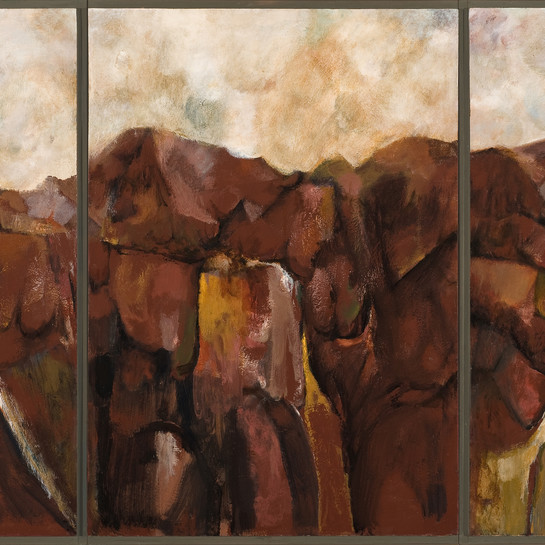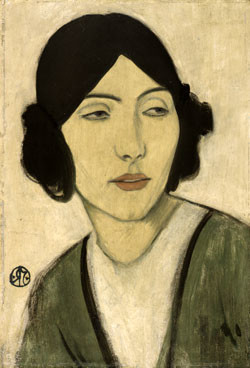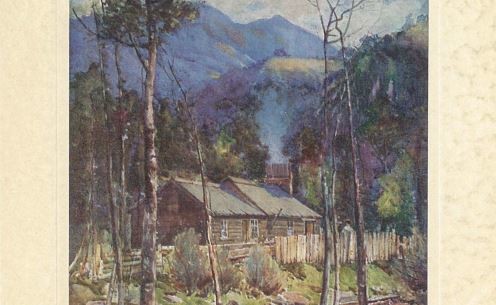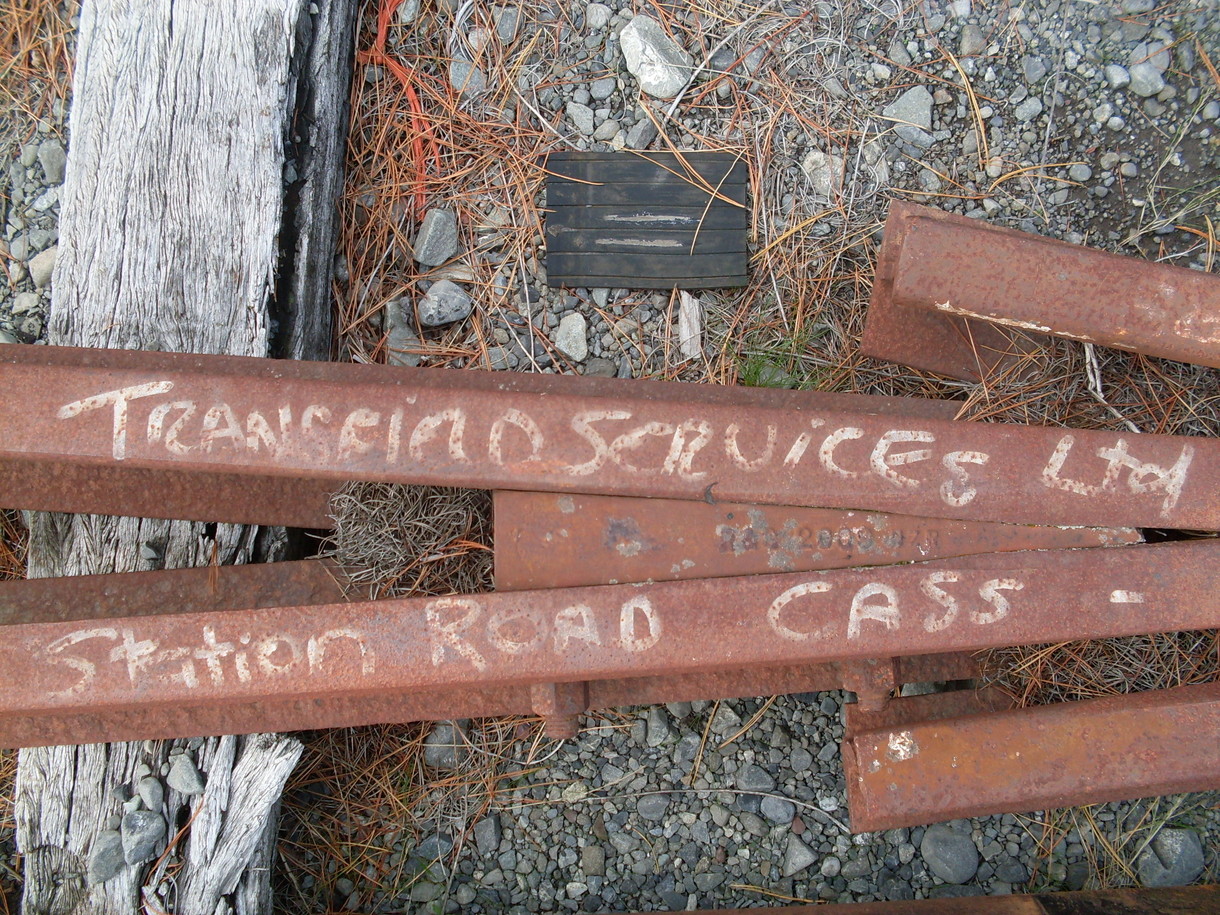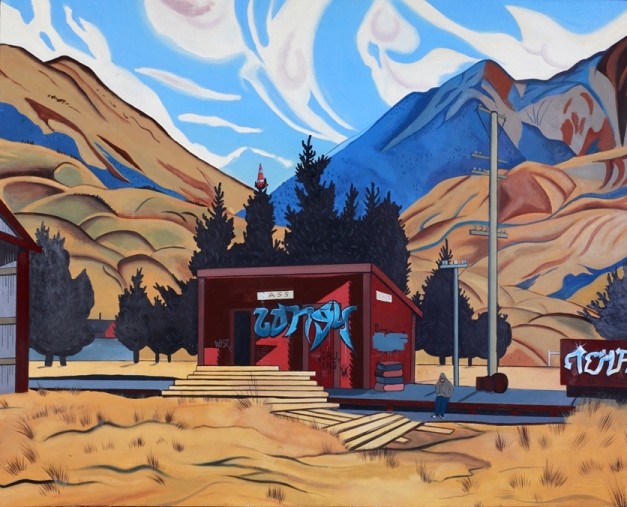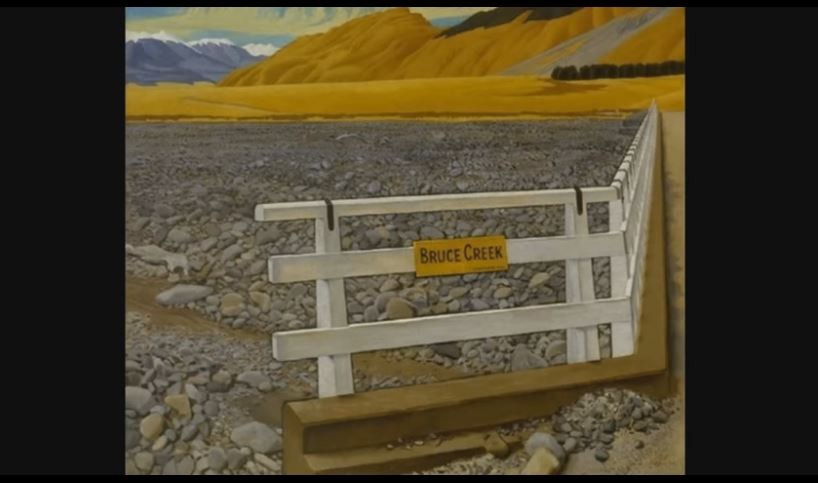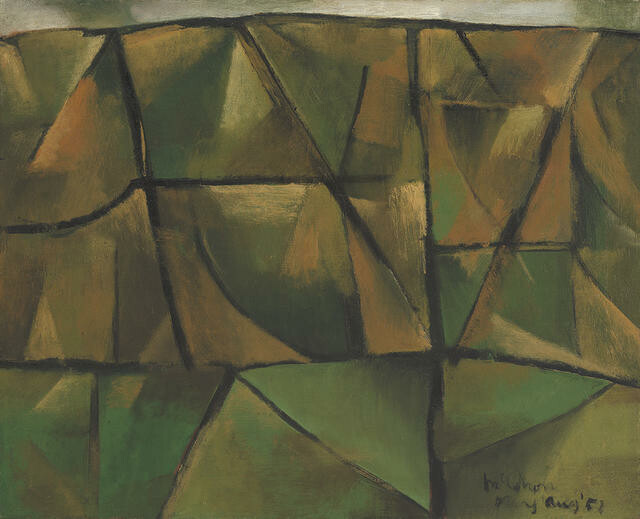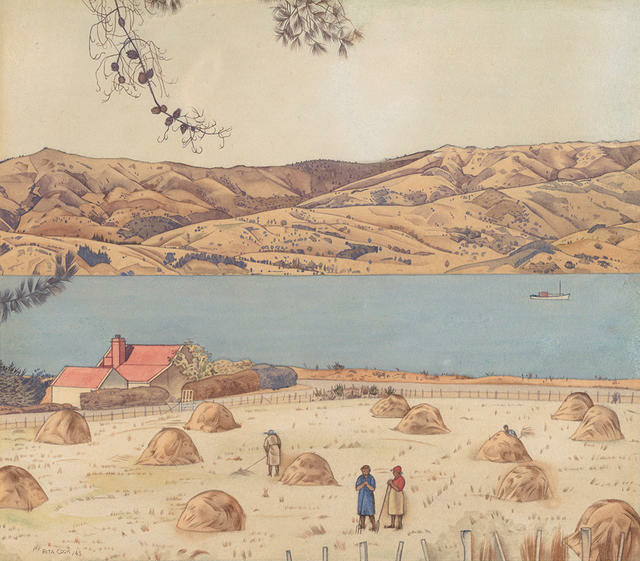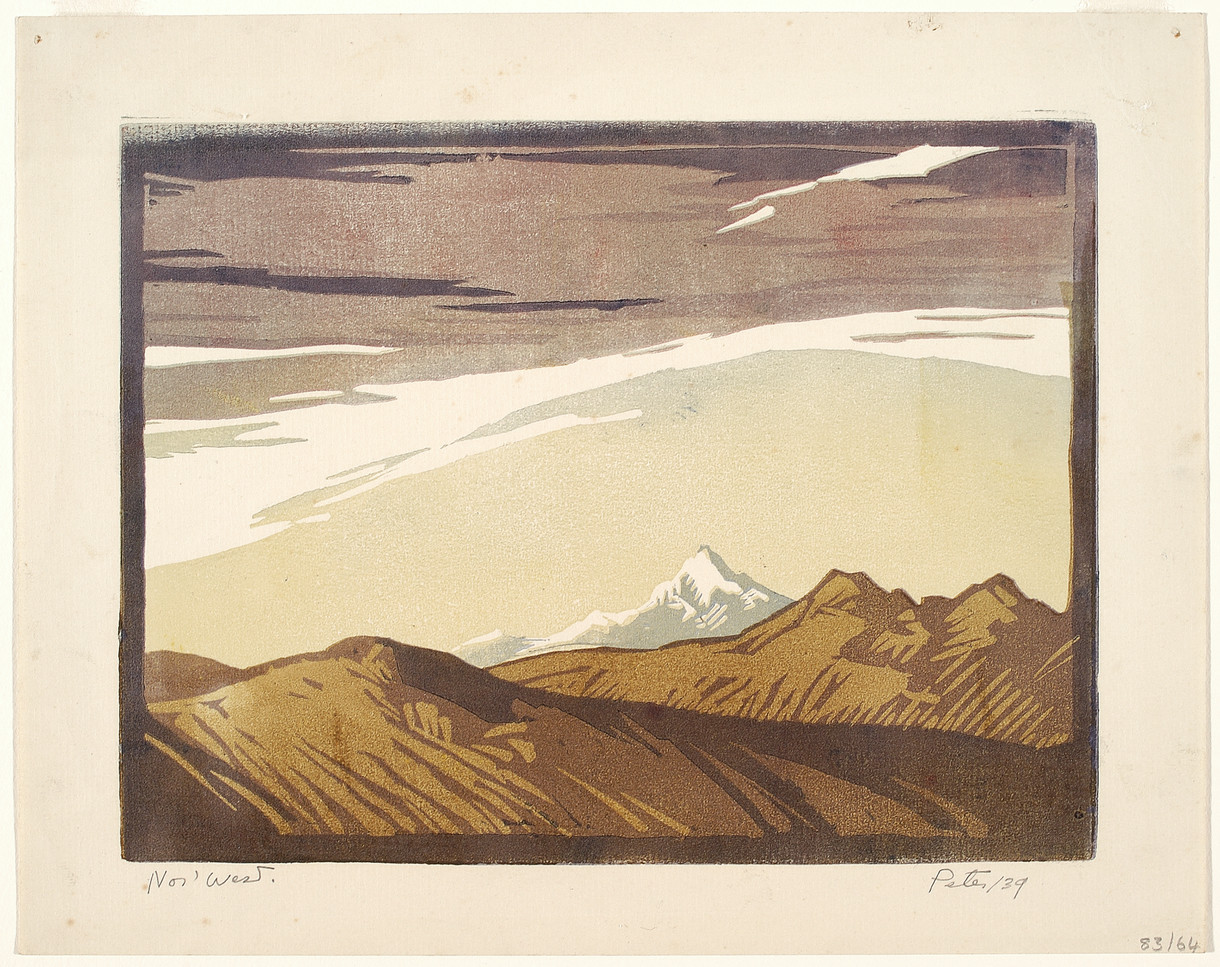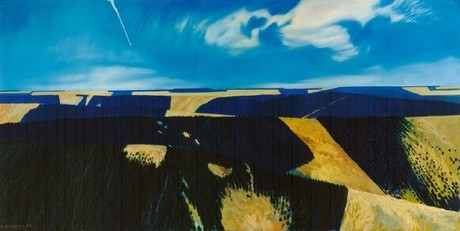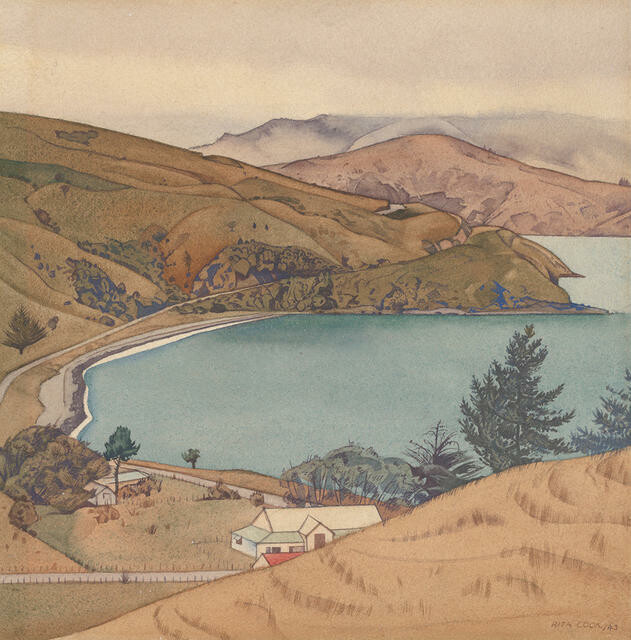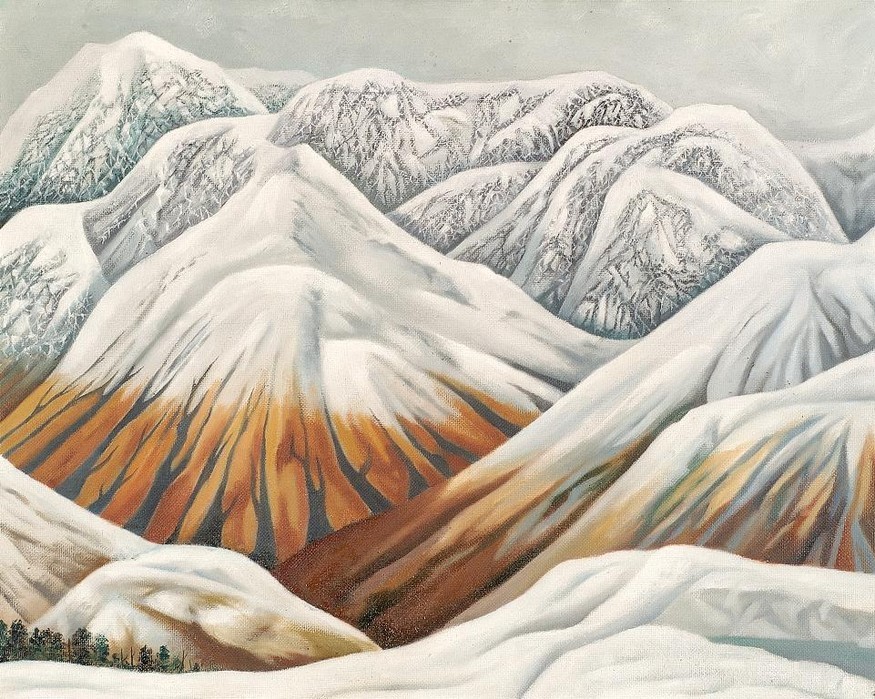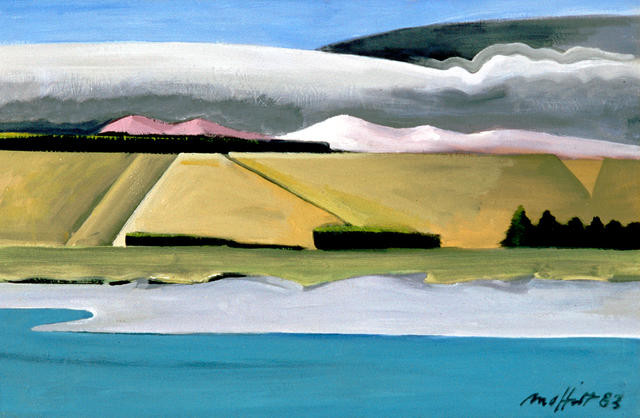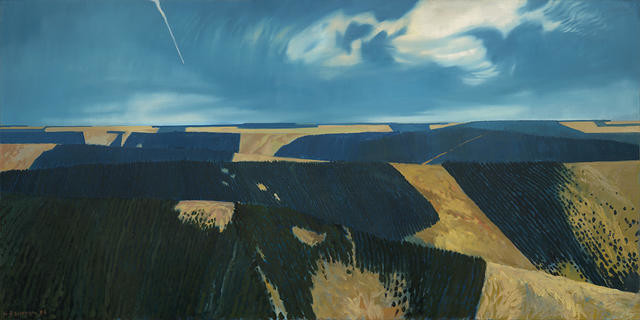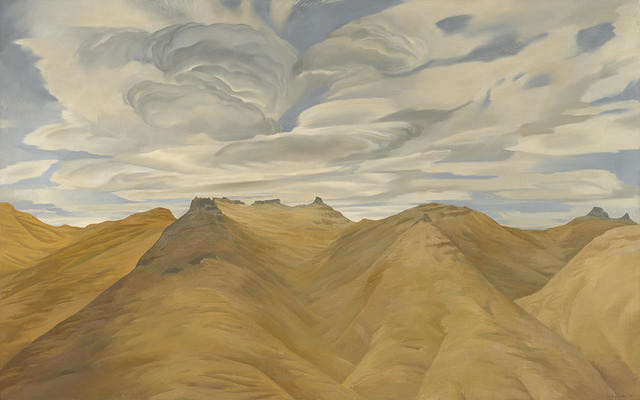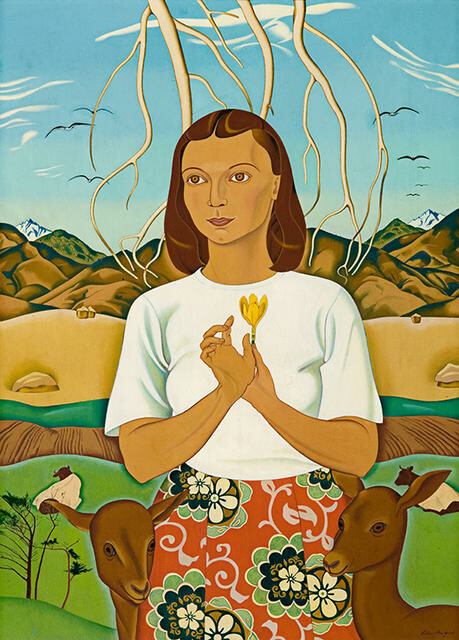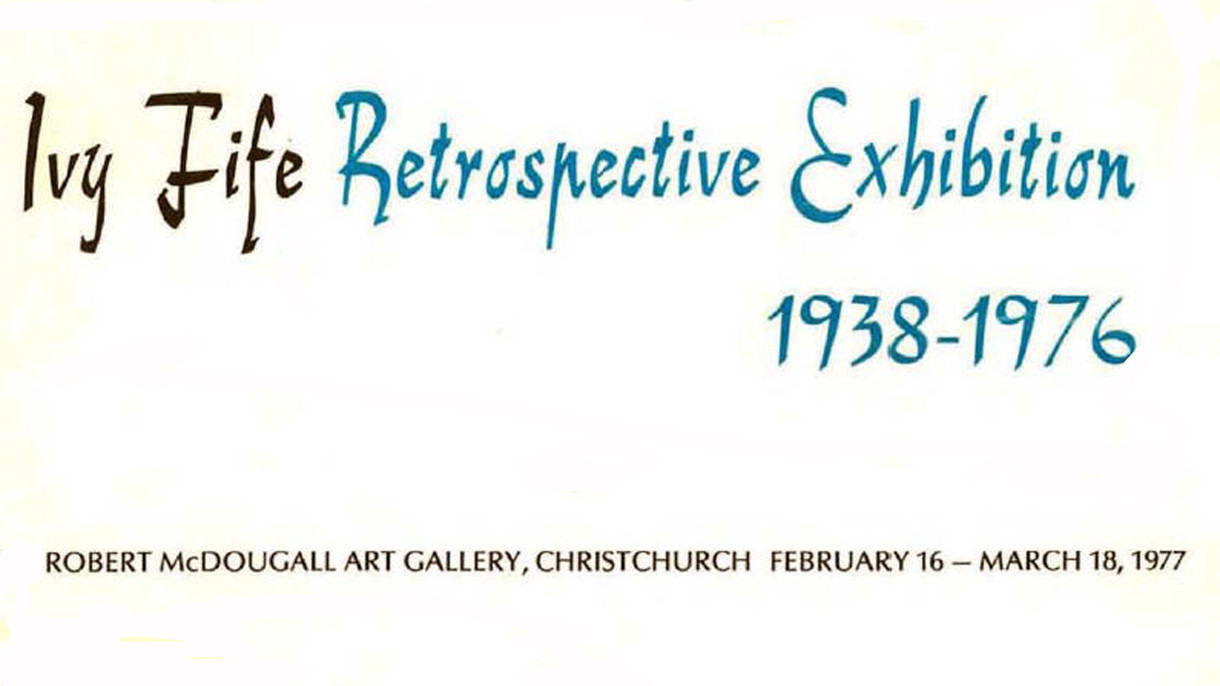Rita Angus
Aotearoa New Zealand, b.1908, d.1970
Cass
- 1936
- Oil on canvas on board
- Purchased 1955
- 550 x 650mm
- 69/74
- View on google maps
Location: Monica Richards Gallery
Tags: buildings (structures), clouds, landscapes (representations), melancholy, mountains, natural landscapes, people (agents), platforms (floors), railroad stations, suitcases, sunlight, trees, utility poles, words, yellow (color)
In the autumn of 1936, Rita Angus, with artist friends Louise Henderson and Julia Scarvell, took a ten-day sketching trip to Cass – a remote outpost on the Midland Line to Te Tai Poutini / the West Coast. Angus completed several works in oil and watercolour in the following months, all showing her attentiveness to human presence in the sweeping landscape. Built structure and material in Cass, her best-known work, includes railway sheds, a stationary wagon, telegraph poles and stacked up timber opposite a solitary waiting passenger. Other finished works from this visit featured a derelict musterers’ hut, and the Canterbury College Mountain Biological Station with a passing steam engine.
(From Here on the Ground, 18 May – 17 November 2024)
The Gallery has recently become aware that an NFT of possibly the best known work in its collection – Cass by Rita Angus – has been created and is currently being promoted and sold (including by auction).
The Gallery wishes to make it clear that while the NFT is authorised by the Rita Angus Estate, it has not authorised, endorsed or approved the creation, marketing or sale of that or of any other NFT, and that neither the Gallery nor the Christchurch City Council is in any way affiliated with the company behind the promotion and sale of the NFT.
At present, the Gallery has no intention of creating NFTs from its collection or supporting their production, and would only consider their creation following consultation with stakeholders including artists, estates, donors, iwi and other interested parties to determine whether or not it is appropriate for it to do so.
Exhibition History
Absence, 6 May – 20 August 2023
This work by Rita Angus has come to symbolise the hard-edged clarity of the Canterbury school of landscape painting. It was made following the artist’s ten-day visit to the remote high country railway settlement of Cass in 1936 with painters Louise Henderson and Julia Scarvell. The Canterbury style was also associated with an atmosphere of isolation and emptiness, often emphasised through small signs of human occupation and intervention placed within a much larger natural environment. While these aspects play an important role in Cass, the work also benefits from a sense of expectation, as we wait, with that solitary, overcoat-clad figure, for the train to arrive.
Perilous: Unheard Stories from the Collection, 6 August 2022
Working alongside her friends Louise Henderson and Julia Scarvell in the high country of Te Waipounamu, Rita Angus made sketches for this now-famous view of the small railway station at Cass. Though it went unsold at its first exhibition, she came to value it highly, seeing a clarity and truthfulness in her sharply focused treatment of the scene. As she later recalled: “[T]hose days of clear blue green skies, sun setting behind the dark hills, cold shadows … They were happy days. I long for a later return into the mountains. How little did I think then … that Cass would come to have any meaning to the painter.”
As Time Unfolds, 5 December 2020 – 7 March 2021
The sweeping clouds, rumpled hills and sharp-edged brightness of Rita Angus’s Cass came together in a brilliant fusion of invention and accomplishment following a ten-day stay at the remote high country railway settlement in the autumn of 1936. Boosted by the company of fellow artists Louise Henderson and Julia Scarvell, and alert to the setting’s barren beauty, she had strong influences to draw on. Henderson, who had arrived from Paris in 1925 and taught at Canterbury College School of Art from 1927, was one. Other influences seen are Japanese woodblock prints and the art of the Northern Renaissance, both detected in the work’s overall sharp focus and decorative, flat, patterned sections.Some ten years after painting this work, Angus recalled the experience: [T]hose days of clear blue green skies, sun setting behind the dark hills, cold shadows … They were happy days. I long for a later return into the mountains. How little did I think then … that Cass would come to have any meaning to the painter.
In 1930s New Zealand there was wide discussion about what was unique about the New Zealand situation; what it was that made us different from the rest of the world. Artists and writers began exploring ways to identify our national identity. A number of artists began painting the Canterbury High Country, most famously Rita Angus and her landscape painting of the railway station at Cass. One reviewer in 1936 observed that there was a new quality in the landscapes exhibited in Christchurch that seemed ‘to consist in a removal of the romantic mists which used to obscure mountains and the Canterbury countryside generally. The light now is clear and hard, the colours are in flat planes, and the effect is of seeing the country through a gem-like atmosphere. There is also a new romantic standpoint – an insistence on the isolation and brooding loneliness of the hills.’ It’s a statement that certainly rings true with the Canterbury paintings of Rita Angus, Leo Bensemann, Louise Henderson, Rata Lovell-Smith and Bill Sutton.
(March 2018)
He Rau Maharataka Whenua: A Memory of Land, 17 September 2016 – 18 February 2017
'The word for a pass or saddle in Māori is nonoti or noti; Noti Raureka is the Browning Pass, not that far from Cass, which is closer in proximity to Arthur’s Pass. There’s a story about a woman named Raureka of the Ngāti Wairaki tribe on the West Coast. Raureka travelled to the east coast carrying a piece of pounamu [greenstone], which is a traditional story of how the eastern migrants found out about pounamu. I often doubt that explanation. By the seventeenth century, when Kāi Tahu were coming here, they knew about pounamu but not of the routes required to reach it. Finding a route to the West Coast was important. The man who becomes significant in that story is Te Rakitāmau, who features in the traditional accounts of the routes across the Alps. In later years, the Noti Raureka route was reserved for war parties and for freighting pounamu back to Kaiapoi. The Lewis Pass was preferred because it’s an easier walk with freight, and Browning is quite stiff.' —Sir Tipene O’Regan
In the vast emptiness, 8 January - 21 August 2016
In the mid 1940s Rita Angus wrote to her close friend, the composer Douglas Lilburn: 'Recently I have come to realise the importance Cass has come to have in my life.' She treasured this painting and resisted approaches to sell it until she left Christchurch in 1954 at which time she sold it to the Gallery. The painting acted as a visual reminder for the artist of the days she spent painting with Louise Henderson and Julia Scarvell in May 1936. Her fondness for Cass, a small, scenic locality in Canterbury's high country, is also highlighted in another letter to Lilburn:
'I have just finished reading through a story I wrote of Cass, descriptions have taken me back to those days of clear blue green skies, sun setting behind the dark hills, cold shadows, thin smoke from the chimney ascending in a straight line. They were happy days, I long for a later return into the mountains. How little did I think then, or foresee my life these last ten years, or that Cass would come to have any meaning to the painter.'
Angus loved that 'the landscape becomes alive at twilight, and I expect the train to come in.'
Brought to light, November 2009- 22 February 2011
In May 1936 Rita Angus and fellow artists Louise Henderson and Julia Scarvell travelled by train from Christchurch to Cass for a ten day sketching trip. It was from this trip that Angus produced ‘Cass’, one of her most accomplished and celebrated paintings. By this time Angus was developing a style of realism incorporating clearly defined shapes and blocks of strong colour. Her works from this period evoke the Canterbury high country on a fine clear day, when the landscape becomes highly defined and leaves one feeling they can see forever. Angus draws our attention to built structures by placing them prominently in the centre of the composition; human interaction with the environment is enhanced further with the inclusion of introduced exotic pine trees, which are shown claiming the landscape as their own. In a similar way Louise Henderson’s painting ‘Plain and hills’, the result of the same trip, depicts pine trees scattered throughout the Cass landscape.
Cass is 116 kilometres north-west of Christchurch, in the Southern Alps. Rita Angus has captured the isolation of this tiny settlement, with its small railway station, populated by a single waiting figure, set against dominating landforms. Angus has used a distinctive style of realism, with clearly defined shapes, blocks of strong colour and a clear, pervading light. She was searching for ways to combine her own experience of the area and the essential nature of the region. The colours are seen as typical of the Canterbury School of artists.
Angus was born in Hastings. She studied at the Canterbury College School of Art from 1927 to 1933. In 1930 she married Canterbury artist Alfred Cook (1907-1971) and, although they separated in 1934, she signed her work ‘Rita Cook’ until 1941. She lived and worked in Christchurch until 1955 when she moved to Wellington. In 1958 Angus was awarded an Association of New Zealand Art Societies Fellowship which allowed her to visit England and Europe where she studied old masters as well as contemporary art. (Opening Gallery hang, 2003)
In 1936 she worked on the first major series of oils and watercolours based on the landscapes around Cass which lies 116 Kilometres north-west of Christchurch. It was at a small, largely unpopulated place where travellers passed in trains, or stopped off briefly in transit. This painting documents that isolation. A small, solitary railway station building with a single waiting figure is set against the dominating landforms. The railway station is the focal point of this deliberate and precisely balanced composition. Using clearly defined shapes, blocks of strong colour and a clear, all pervading light, she was searching for ways in which her own experience of the locality and the essential nature of the region could be combined in a painting. Each area of the composition has been given equal emphasis, breaking away from the traditional styles of New Zealand landscape painting. (Label from before 2003)





